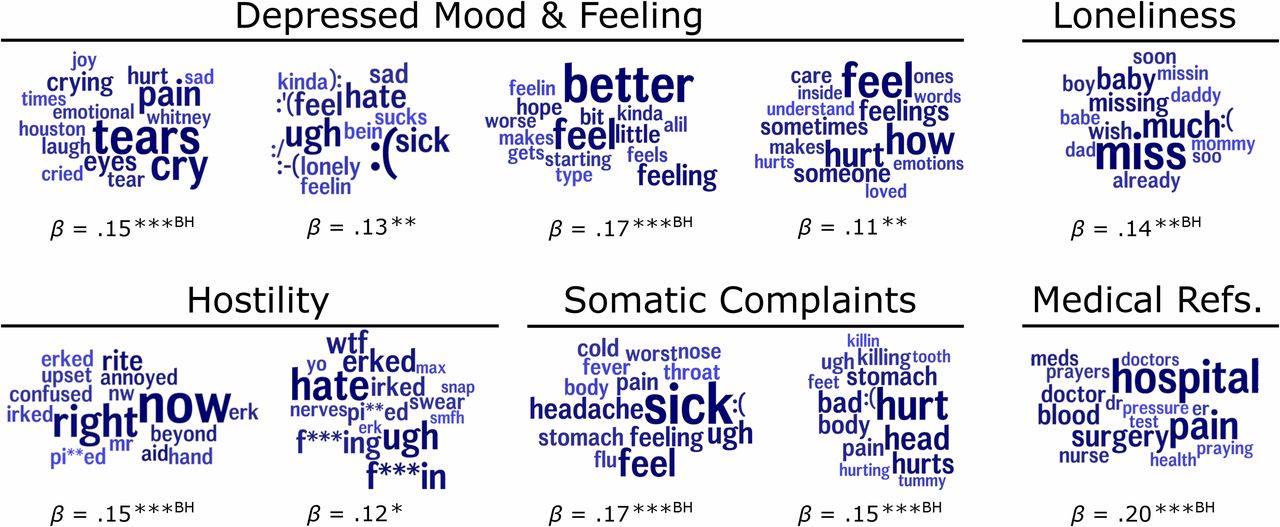
At the end of last year, there were 5.8 million patients with mental illness in Russia . The number of mental disorders is increasing from year to year, which significantly burdens international health systems. Scientists are actively looking for ways to diagnose diseases early. One of these methods was proposed by American researchers using one of the most popular services in the world - Facebook.
The social network has long been familiar with each of us very closely. But how far can you go in this knowledge if you carefully analyze personal information, the tone of messages sent, the semantics of words in posts, and even pay attention to the selected filter in the photo? It turns out that mental problems in Facebook users can be identified at the earliest stages.
A group of researchers from the Institute for Medical Research. Feinstein in early December announced the creation of an algorithm that makes it possible to identify deviations from Facebook users using previously sent messages and photos. The details are just below.
Research Director, Associate Professor at the Institute of Medical Research named after Feinstein, Michael Birnbaum believes that the created algorithm is very important for the detection and treatment of disorders. He claims that now treatment is started quite late, and such methods will help to see the picture of the disease in the early stages and will become the basis for an immediate start of treatment.
How did the research go?

To conduct a large-scale study, the team obtained access to data from 223 volunteer users of the social network. The AI algorithm analyzed messages, statuses and photos posted by them. The purpose of the analysis is to understand if the volunteers had any abnormalities: bipolar disorder or depression, schizophrenic spectrum disorder, or generally unstable mental state.
The analysis results showed the following.
- The use of obscene words characterizes people with mental illness.
- Frequent use in the text of the verbs of perception: see, feel, hear, as well as words describing negative emotions, speaks of schizophrenia.
- Cold bluish tints in photographs are associated with emotional disturbance.
Of course, not all lovers of strong words are potential patients in a psychiatric hospital. Just like lovers of blue / cyan colors, they have no deviations. We are talking about a combination of a number of factors that can serve as a marker of the problem.
Assessment of results
To assess the adequacy of the results obtained, the researchers resorted to a generalized indicator that finds a compromise between false positives for triggers and false negatives, which are also inevitable. Scientists received a diagnosis accuracy rating of 0.65 to 0.77 for their system, depending on the original database. This is a good result. To understand the assessment, let us explain that the accuracy of an ideal algorithm, without false reactions, is 1. The accuracy of an algorithm trying to make a diagnosis at random is 0.5.
According to the assistant professor of computer science at the State University of New York at Stony Brook, H. Andrew Schwartz, the achieved accuracy is comparable to the results of the standard PHQ-9 test. Therefore, it is highly likely that the data from the social network can actually be used to screen for mental disorders. By the way, the PHQ-9 test can be taken online .
Of the important features of the experiment. Scientists led by Birnbaum had confirmed diagnoses of patients from psychiatrists with exact dates, and got access to accounts on the social network after that. And analyzed information from the past.
Fortunately, it is impossible to send a person to a medical institution on the basis of only his manner of communication in a social network, and in the near future it is unlikely that something will change in this regard. This is confirmed by Sharat Guntuku, Associate Professor of the Department of Computer Science at the University of Pennsylvania. He did not take part in the research and gives his independent opinion. So, he believes that before his eyes there will not come a time when only data from social networks will be used for diagnostics. But there is good news, as this information can become a source of additional data, helping to identify people at risk.
The benefits of social media

Scientists themselves say that diagnosing mental illness is an imprecise science. It can be qualitatively improved and developed by adding new data sources. Social networks can become one of such tools. Why are they useful for psychiatrists? The same Facebook provides a continuous recording of a person's thoughts and actions for a fairly long period of time. These data can provide added value and enrich the physician's knowledge of the patient. Traditionally, psychiatrists receive information and diagnose patients in one-hour clinical interviews.
In addition, Facebook data can help monitor the patient's condition during the long-term treatment / recovery phase. Emotions, feelings, thoughts of patients are very dynamic, but psychiatrists, at best, make a cut once a month. Tracking patients' personal feed data will help doctors get a better picture and adjust treatment.
What else is Facebook silent about?
The described case is far from the first time that doctors have turned to social media.
Researchers have already used Facebook statuses , tweets on Twitter, and Reddit posts to diagnose depression, attention deficit hyperactivity disorder.
To analyze Facebook statuses, doctors used data from 114 patients with a confirmed diagnosis of depression. Based on the date of the official diagnosis, the researchers analyzed all posts and user statuses up to that time.
The diagnosis prediction model took into account the following information:
- message length;
- frequency of publications;
- a period of time;
- demographic data.
The results of the study showed that Facebook gives the same prediction accuracy as other already known self-diagnosis tests for depression.

Source
Scientists have named emotional language markers of depressive mood:
- description of the state of sadness;
- pronounced hostility;
- tears, crying, pain;
- mention of loneliness and words: miss, a lot, child;
- negative emotions with common words: smh, f * ck, hate.
Also, people with depressive disorder used more single-person first-person pronouns, which is related to their preoccupation with themselves and their condition.
In addition, the study found that the average annual number of words in messages was 1,424 more for users who were eventually diagnosed with a mental disorder.
